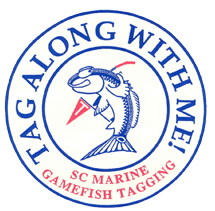Marine - Species
Atlantic Croaker (Micropogonias undulatus)
General Description
Silvery overall, often with pinkish-bronze tint. Narrow, dark lines or rows of spots on back. Dorsal fin spotted. Preopercle has several prominent spines. Lower jaw with several small barbels on inner edge, mouth inferior and horizontal.
Average Size
9 inches, 0.5 pounds;
South Carolina State Record: 4 pounds, 9 ounces (1979);
maximum age: approx. 2 years (may be 7 – 8 years north of Cape Hatteras)
Habitat
Adults: Common over mud and sandy bottom; also over oyster reefs and live bottoms. Tolerate a range of salinities, but prefer moderate salinity.
Juveniles: Utilize low salinity upper reaches of estuaries, primarily associated with muddy bottoms or detritus-laden habitats; progress to higher salinity with age; overwinter in deeper channels and tidal rivers within estuaries.
Reproductive Cycle
- Adults mature at 1 – 2 years of age; approx. size at maturity: males – 5 ½ inches, females – 7 inches.
- Spawning occurs over continental shelf during fall and winter.
- Larvae use tidal currents to reach nursery grounds in low salinity tidal creeks at the upper reaches of estuaries; inshore larval migration peaks late fall – spring.
Foraging Habits
- Mouth faces downward and can be formed into a tube to suction prey from on or within bottom sediments.
- Adults: Feed primarily on marine worms, small shrimp and crabs, clams, and some fishes.
- Juveniles: Consume copepods, amphipods, mysid shrimp, worms, and detritus. Diet of larger juveniles and subadults is similar to adult fish. Larvae consume predominantly copepods.
Availability/Vulnerability to Harvest
- Present in South Carolina waters year-round. Seasonal movement related to spawning; may also be temperature regulated. Age 1 + fish overwinter offshore and may leave estuaries as water cools during fall. Spawning migrations may occur before any seasonal temperature decline.
- Among the most abundant bottom-dwelling fish in Atlantic estuarine, coastal, and nearshore waters. Large interannual variability in population size and inshore recruitment exists, probably due to significant larval mortality caused by environmental factors (especially cold winters).
- No commercial fishery for Atlantic croaker exists in South Carolina. However, the species experiences significant recreational fishing pressure.
- Conservation concerns: degradation or loss of estuarine nursery habitat, compromised water quality, lack of adequate catch data for South Carolina waters; potential for overfishing.
Literature Cited
Lassuy DR. 1983. Species profiles: life histories and environmental requirements (Gulf of Mexico) – Atlantic croaker. U.S. Fish and Wildlife Service, Division of Biological Sciences. FWS/OBS-82/11.3. U.S. Army Corps of Engineers, TR EL-82-4. 12pp. Available: https://pubs.er.usgs.gov/publication/fwsobs82_11_3. Access: August, 2009.
Mercer LP. 1989. Fishery management plan for Atlantic croaker (Micropogonias undulatus). Fishery Management Report no. 10, Atlantic States Marine Fisheries Commission, Washington DC. 90 pp.
Miglarese JV, CW McMillan, MH Shealy. 1982. Seasonal abundance of Atlantic croaker (Micropogonias undulatus) in relation to bottom salinity and temperature in South Carolina estuaries. Estuaries 5: 216-223.
Moore CJ, M Barkley. 2005. South Carolina's guide to saltwater fishes. South Carolina Department of Natural Resources, Special Publication. Columbia, SC. 132 pp.
Parker JC. 1971. The biology of the spot, Leiostomus xanthurus Lacépède, and Atlantic croaker, Micropogon undulatus (Linnaeus), in two Gulf of Mexico nursery areas. Texas A&M University, College Station, TX. 182 pp.
Whitaker JD. 2005. Atlantic croaker. In: Comprehensive Wildlife Conservation Strategy. South Carolina Department of Natural Resources, Columbia, SC. Available: https://www.dnr.sc.gov/cwcs/pdf/Croaker.pdf. Accessed: September, 2009.


